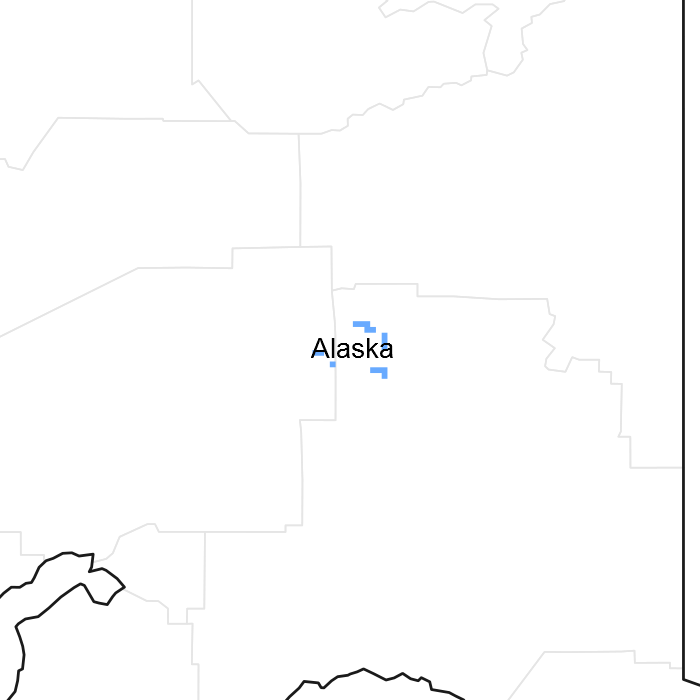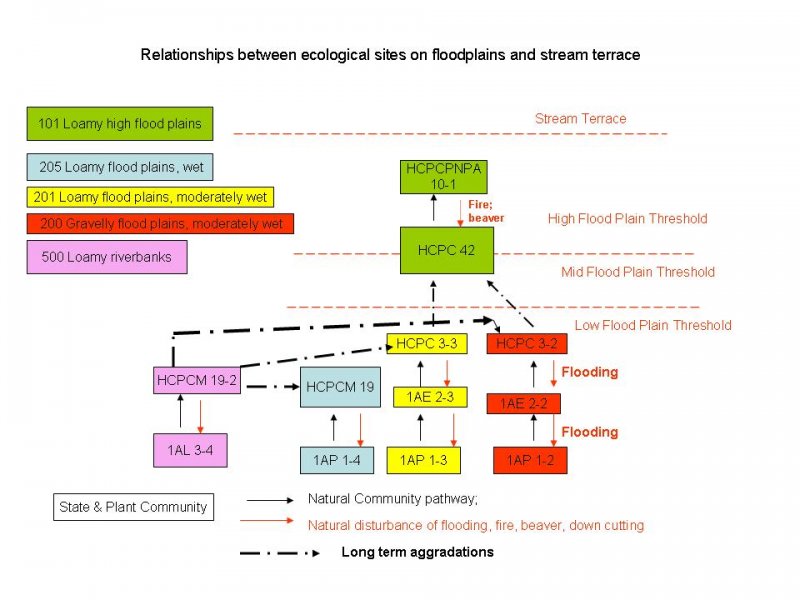
Natural Resources
Conservation Service
Ecological site R227XY500AK
Loamy Riverbanks
Accessed: 12/21/2025
General information
Provisional. A provisional ecological site description has undergone quality control and quality assurance review. It contains a working state and transition model and enough information to identify the ecological site.

Figure 1. Mapped extent
Areas shown in blue indicate the maximum mapped extent of this ecological site. Other ecological sites likely occur within the highlighted areas. It is also possible for this ecological site to occur outside of highlighted areas if detailed soil survey has not been completed or recently updated.
Table 1. Dominant plant species
| Tree |
Not specified |
|---|---|
| Shrub |
Not specified |
| Herbaceous |
Not specified |
Physiographic features
This site occurs along the continuously wetted banks of low to moderate gradient, clear water rivers and streams. Areas occupied by this site are typically 2 to 40 feet (0.6 to 12 m) wide along the edges of the channel and sloughs. Terrace height above the mean summer channel level is typically less than 2 feet (0.6 m). During periods of peak runoff, most or all of this site is under water. As the water level drops during the course of the summer, the site becomes progressively more exposed. The water table, however, remains at or near the surface throughout the growing season. Soil slope ranges from nearly level on top of the flood plain or terrace to moderately steep at the edge of the channel. Elevation is 1850 to 2900 feet (564 to 884 m).
This site is found throughout the Gulkana River area but is most prevalent along the Middle Fork, the Main Stem north of canyon rapids, the upper reaches of the North and South Branches, and the lower reaches of the West Fork. This site undoubtedly occurs along other low to moderate gradient streams and rivers elsewhere in the Copper River basin.
Table 2. Representative physiographic features
| Landforms |
(1)
Flood plain
|
|---|---|
| Flooding duration | Brief (2 to 7 days) to long (7 to 30 days) |
| Flooding frequency | Frequent |
| Elevation | 564 – 884 m |
| Water table depth | 5 – 30 cm |
| Aspect | Aspect is not a significant factor |
Climatic features
The subarctic continental climate of this site is characterized by long cold winters and short warm summers. Mean January temperature is -2 °F.; mean July temperature is 54 °F. Mean annual precipitation ranges from 15 to 21 inches. Annual snowfall ranges from 54 to 102 inches. The frost-free season is about 60 to 80 days (28 °F. base temperature). The growing season varies greatly from year to year and frosts can occur during any summer month.
Table 3. Representative climatic features
| Frost-free period (average) | 0 days |
|---|---|
| Freeze-free period (average) | 0 days |
| Precipitation total (average) | 0 mm |
Figure 2. Monthly average minimum and maximum temperature
Influencing water features
Soil features
The weakly developed soils on this site typically are formed in stratified sandy and silty alluvium over very gravelly and cobbly alluvium. Depth to gravel and cobble ranges from occasionally less than 10 inches (25 cm) to 60 inches (152 cm) or more. Depth to seasonal high water table ranges from 4 inches (10 cm) above the surface during peak runoff to an average of about 12 inches (30 cm) below the surface during most of the remainder of the growing season and the soils are very poorly drained. Aquic conditions including redox depletions and/or a reduced matrix are present within 10 inches (25 cm) of the soil surface.
Table 4. Representative soil features
| Surface texture |
(1) Fine sandy loam (2) Fine sand (3) Sandy loam |
|---|---|
| Drainage class | Poorly drained |
| Soil depth | 152 cm |
| Available water capacity (0-101.6cm) |
0.25 – 0.38 cm |
Ecological dynamics
Vegetation on this site is probably stable under existing site conditions. Channel migration and down-cutting, which reduces flooding duration or lowers the water table would allow various Salix and, in the alder zone, Alnus tenuifolia to become established and Calamagrostis canadensis, Arctagrostis latifolia, and other herbs to increase in abundance.
Because of the continuously wet conditions, this site is not likely to burn or be impacted by wild fires.
State and transition model

More interactive model formats are also available.
View Interactive Models
More interactive model formats are also available.
View Interactive Models
Click on state and transition labels to scroll to the respective text
Ecosystem states
State 1 submodel, plant communities
State 2 submodel, plant communities
State 1
Low willow-water sedge scrub
Community 1.1
Low willow-water sedge scrub
Low willow/water sedge scrub consists of occasionally open to closed willow 2 to 4 feet (0.6 to 1.2 m) in height, with a moderately open to closed layer of water sedge in the understory. Ponded water is common to well-represented on the ground surface. Shrub canopy cover typically ranges from 50 to 90 percent, although it is frequently less in stands transitional to the sedge-grass riparian meadow cover type. Dominant willows include Salix planifolia and S. barclayi. Other shrubs are relatively unimportant except for Potential fruticosa, which is common in most stands. Canopy cover of the herbaceous layer is variable but usually ranges from 50 to over 75 percent. Carex aquatilis is the dominant herb; other herbs are usually of minor importance. Frequently occurring species include Calamagrostis canadensis, Potential palustris, and Salix reticulata and Rubus arcticus on slightly elevated microsites. Aquatic mosses are usually abundant in low microsites. Setting Low willow/water sedge scrub is generally too wet for tree growth. Where it occurs, this cover type is presumably potential vegetation. Towards the wet extreme of the type, Low willow/water sedge is transitional to Sedge-grass riparian meadow. Willow canopy cover drops to as little as 25 percent and the distinction between the scrub and meadow types becomes arbitrary. In many places, site conditions favorable to Low willow/water sedge scrub appear to be maintained by beaver activity. Elsewhere, conditions are maintained by proximity to the river channel. A change in beaver activity or down-cutting or migration of the channel improves drainage and could cause a succession of the vegetation toward Low willow/herb scrub. Riparian-Wetland Classification: Palustrine scrub-shrub, semi-permanently flooded, mineral (Cowardin et al. 1979); riparian
Table 5. Ground cover
| Tree foliar cover | 1-7% |
|---|---|
| Shrub/vine/liana foliar cover | 1-85% |
| Grass/grasslike foliar cover | 1-80% |
| Forb foliar cover | 1-15% |
| Non-vascular plants | 10-90% |
| Biological crusts | 0% |
| Litter | 1-70% |
| Surface fragments >0.25" and <=3" | 0% |
| Surface fragments >3" | 0% |
| Bedrock | 0% |
| Water | 0% |
| Bare ground | 1-5% |
State 2
Low willow/herb scrub
Community 2.1
Low willow/herb scrub
Low willow/herb scrub consists of moderately open to closed willow 2 to 7 feet (0.6 to 2.1 m) in height with a moderately closed to closed herb layer. Low shrub canopy cover ranges from 40 to 95 percent. Dominant shrubs include Salix planifolia, S. barclayi, and often S. monticola. S. alaxensis forms an open tall shrub layer in some stands. Other low shrubs are relatively unimportant except for Potentilla fruticosa and Vaccinium uliginosum. In most stands, the herb layer is composed of a rich variety of species. Herb and dwarf shrub canopy cover is typically greater than 80 percent. Occasionally the herb layer is only sparse to open. Important herbs include Calamagrostis canadensis, Epilobium angustifolium, Equisetum spp., Mertensia paniculata, Polemonium acutiflorum, Swertia perennis, and often Carex aquatilis. Rubus arcticus and Salix reticulata are common dwarf shrubs in many stands. The ground surface is covered with feathermoss patches and herbaceous and woody litter.
Table 6. Ground cover
| Tree foliar cover | 1-10% |
|---|---|
| Shrub/vine/liana foliar cover | 1-91% |
| Grass/grasslike foliar cover | 2-10% |
| Forb foliar cover | 1-5% |
| Non-vascular plants | 1-75% |
| Biological crusts | 0% |
| Litter | 5-50% |
| Surface fragments >0.25" and <=3" | 0% |
| Surface fragments >3" | 0% |
| Bedrock | 0% |
| Water | 0% |
| Bare ground | 1% |
Additional community tables
Interpretations
Supporting information
Contributors
Michelle Schuman
Rangeland health reference sheet
Interpreting Indicators of Rangeland Health is a qualitative assessment protocol used to determine ecosystem condition based on benchmark characteristics described in the Reference Sheet. A suite of 17 (or more) indicators are typically considered in an assessment. The ecological site(s) representative of an assessment location must be known prior to applying the protocol and must be verified based on soils and climate. Current plant community cannot be used to identify the ecological site.
| Author(s)/participant(s) | |
|---|---|
| Contact for lead author | |
| Date | |
| Approved by | |
| Approval date | |
| Composition (Indicators 10 and 12) based on | Annual Production |
Indicators
-
Number and extent of rills:
-
Presence of water flow patterns:
-
Number and height of erosional pedestals or terracettes:
-
Bare ground from Ecological Site Description or other studies (rock, litter, lichen, moss, plant canopy are not bare ground):
-
Number of gullies and erosion associated with gullies:
-
Extent of wind scoured, blowouts and/or depositional areas:
-
Amount of litter movement (describe size and distance expected to travel):
-
Soil surface (top few mm) resistance to erosion (stability values are averages - most sites will show a range of values):
-
Soil surface structure and SOM content (include type of structure and A-horizon color and thickness):
-
Effect of community phase composition (relative proportion of different functional groups) and spatial distribution on infiltration and runoff:
-
Presence and thickness of compaction layer (usually none; describe soil profile features which may be mistaken for compaction on this site):
-
Functional/Structural Groups (list in order of descending dominance by above-ground annual-production or live foliar cover using symbols: >>, >, = to indicate much greater than, greater than, and equal to):
Dominant:
Sub-dominant:
Other:
Additional:
-
Amount of plant mortality and decadence (include which functional groups are expected to show mortality or decadence):
-
Average percent litter cover (%) and depth ( in):
-
Expected annual annual-production (this is TOTAL above-ground annual-production, not just forage annual-production):
-
Potential invasive (including noxious) species (native and non-native). List species which BOTH characterize degraded states and have the potential to become a dominant or co-dominant species on the ecological site if their future establishment and growth is not actively controlled by management interventions. Species that become dominant for only one to several years (e.g., short-term response to drought or wildfire) are not invasive plants. Note that unlike other indicators, we are describing what is NOT expected in the reference state for the ecological site:
-
Perennial plant reproductive capability:
Print Options
Sections
Font
Other
The Ecosystem Dynamics Interpretive Tool is an information system framework developed by the USDA-ARS Jornada Experimental Range, USDA Natural Resources Conservation Service, and New Mexico State University.
Click on box and path labels to scroll to the respective text.